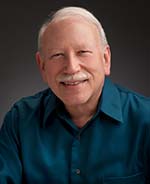Joel Primack

Joel R. Primack, Distinguished Professor of Physics at the University of California, Santa Cruz, specializes in the formation and evolution of galaxies and the nature of the dark matter that makes up most of the mass in the universe. Primack received his A.B. in Physics summa cum laude from Princeton in 1966 and his Ph.D. in Physics from Stanford in 1970. He became a Junior Fellow of the Society of Fellows of Harvard University, and in 1973 joined the UCSC faculty. After helping to create what is now called the "Standard Model" of particle physics, Primack began working in cosmology in the late 1970s and he became a leader in the new field of particle astrophysics. He is one of the principal originators and developers of the theory of Cold Dark Matter, which has become the basis for the standard modern picture of structure formation in the universe. With support from the National Science Foundation, NASA, and the Department of Energy, he is currently using supercomputers to simulate and visualize the evolution of the universe under various assumptions, and comparing the predictions of these theories to the latest observational data.
Primack has supervised part or all of the research of 40 graduate students and 10 postdocs. He was made a Fellow of the American Physical Society (APS) in 1988 "for pioneering contributions to gauge theory and cosmology." He was elected to the Executive Committee of the APS Division of Astrophysics 2000-2002. He has won awards for his research from the A. P. Sloan Foundation and the Alexander von Humboldt Foundation.
Primack's research in cosmology is described in most modern books on the subject, and he has been profiled at some length in several books including New York Times science writer Dennis Overbye's Lonely Hearts of the Cosmos and former Time magazine science editor Michael Lemonick's The Light at the Edge of the Universe. He was one of the main advisors for the Smithsonian Air and Space Museum's 1996 IMAX film Cosmic Voyage. In addition to more than 200 technical articles in professional journals, Primack has written a number of articles aimed at a more popular audience. These include the articles on "gravitation," "matter," "dark matter," "dark energy," and other physics and astronomy topics in the World Book Encyclopedia, and articles in publications such as Nature, Science, Astronomy, Sky and Telescope, Beam Line, California Wild, the McGraw-Hill Encyclopedia of Science and the Encyclopedia of Astronomy and Astrophysics. Primack has also been the Lansdowne Lecturer at the University of Victoria, the J. Robert Oppenheimer Memorial Lecturer at Los Alamos, and the Buhl Lecturer at Carnegie Mellon University.
With his wife and collaborator Nancy Ellen Abrams, Primack developed the award-winning course “Cosmology and Culture,” and they have been co-teaching it since 1996 at the University of California, Santa Cruz. This course won awards from the John Templeton Foundation and the American Council of Learned Societies, and was the basis for their first book, The View from the Center of the Universe: Discovering Our Extraordinary Place in the Cosmos (Penguin/Riverhead 2006), now also published in several foreign editions (see http://viewfromthecenter.com/, which also lists their many public talks).
At Yale University in October 2009 they gave the Terry Lectures (search YouTube for “Terry Lectures 2009”), which became the basis for The New Universe and the Human Future: How a Shared Cosmology Could Transform the World (Yale University Press, 2011), with associated website http://new-universe.org .
Since he was a graduate student, Primack has actively sought to get better scientific advice into government. He was a founder of the Union of Concerned Scientists and has served on the board of the Federation of American Scientists (FAS). He started the American Association for the Advancement of Science (AAAS) Congressional Science Fellows Program in 1973, through which scientific societies fund PhD scientists to work in Congress for a year. The program has grown to include many fields of science, and in 1995 Primack was made an AAAS Fellow "for pioneering efforts in the establishment of the AAAS Congressional Science Fellows Program and for dedication to expanding the use of science in policymaking throughout government." In 1977 Primack shared with Frank von Hippel the APS Forum on Physics and Society Award for the book Advice and Dissent: Scientists in the Political Arena (Basic Books, 1974; New American Library, 1976). Primack helped design and create the NSF Science for Citizens Program to fund scientists to advise public interest organizations. He was a charter member of the AAAS Committee on Scientific Freedom and Responsibility, and he started the AAAS Science and Human Rights program. In 1987-89 he led the FAS Space Nuclear Power Arms Control project, which succeeded in ending the USSR’s space nuclear reactor program. His popular articles on efforts to protect the near-Earth space environment, some co-authored with Nancy Ellen Abrams, have appeared in Bulletin of the Atomic Scientists, Science, Scientific American, and Technology Review. Primack has also served as an advisor to and participant in the Science and the Spiritual Quest project and as chairman of the advisory committee for the AAAS Program of Dialogue on Science, Ethics, and Religion 2000-2002.
Primack was a member of the APS Panel on Public Affairs 2002-2004, he chaired an APS committee reporting on NASA funding for astronomy 2004, he chaired the APS Forum on Physics and Society 2005-06, and he chaired the committee on the APS Andrei Sakharov Prize on science and human rights in 2009. He has served on numerous advisory panels to DOE, NASA, and NSF, and on the Beyond Einstein Program Assessment Committee of the National Academy of Sciences/National Research Council. In January 2010, Primack became the first director of the new University of California systemwide High-Performance AstroComputing Center (UC-HiPACC).

